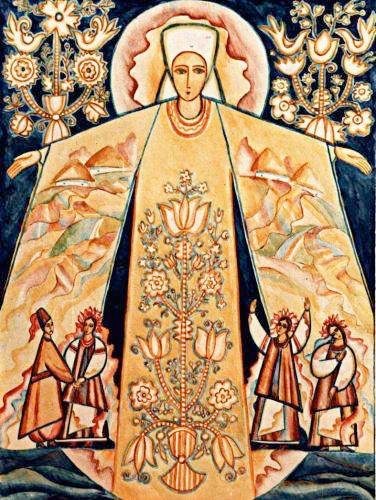Rake Motifs

Rakes are an agricultural symbol, but not because they are farming implements. Ukrainian rakes were made of wood, and looked like this:

Rake symbols (sometimes called combs) were very simple motifs, sometimes just a crossbar with fringe, other times a triangle with a fringe. The symbols shown here are of the first type:



The first two symbols in this row are of the triangle type of rake:

And some versions were more complex, with the base being faceted, circular or irregular:

Rakes/combs are actually water symbols, and represent clouds and rain. They often are shaped like triangles, with the dashed lines representing rain itself. Sometimes the triangles are surrounded by dots, or the rakes have dots in close proximity. These dots symbolize seeds, which are watered by the rain and then grow to yield a bountiful crop.
Rakes are a very common motif on Ukrainian pysanky. This is an example from Binyashevsky, from the Voronezh region:

These are examples of pysanky from the Vinnytsia region featuring rakes:



This pair of red pysanky from Zakarpattia, and a black one from the Donetsk region, exhibit simple rakes:



This sorokoklyn from Zhytomyr has 24 rakes hidden in its intricate design:

These pysanka from Binayshevsky depict traditional “comb” motifs. The one on the left is from Volyn, and is called “Hrebinchyky (Гребінчики)” or little combs. A rake is a “hay comb” in Ukrainian. On the right is a pysanka from Pidliashia, and called simply “Hrebintsi (Гребінці), or combs.


Selivachov, unlike other ethnographers, distinguishes between rakes and combs, and considers the combs to be household combs like those used for combing hair. He notes that the name “Rake” (hrabelky) is more prevalent in Podillia. “Combs” (hrebinchyky), in contrast to rakes, have fewer and longer teeth; also, the teeth of a comb may vary in size and come off the base (which may be multi-faceted, circular, irregular) in various directions.
Selivachov provides us with several examples of hrabelky (rakes) from pysanky, mostly in Podillia (the other examples are from beadwork and embroidery):

PYSANKA MOTIFS
1) Lviv
3)Vinnytsia
4)Vinnytsia
5)Vinnytsia
This second set of symbols form selivachov is of hrebintsi (combs), and they come from all over Ukraine. I must say that I fail to see an observable difference that would make me differentiate the two in most cases, at least on pysanky. (5, 8, 9 and 11 are beekeeper’s signs and embroidery patterns.) Numbers 4, 13 and 18 do stand out as being different, and do demonstrate some of the differences Selivachov enumerated.

14



PYSANKA MOTIFS
1) Sumy
2)Poltava
3)Poltava
4)Podillia
6)Lviv
7)Podillia
10) Poltava
12) Poltava
13) Volyn
14) Poltava
18) Vinnytsia
19) Ivano-Frankivsk
20) Vinnytsia
23) Eastern Podillia
Selivachov describes the various roles of the household comb in folk traditions: it was used in healing, and a girl's umbilical cord was severed on a comb. During baptism, when entering the church, the godfather stepped upon a comb if he was carrying a girl. At the end of the Christmas celebrations festively dressed women brought in a comb dressed up as a girl and placed it in the corner under the icons.
The comb is also an attribute of the goddess Mokosh (Makosh), who was transformed under christianity into the martyr Paraskeva. Mokosh was а strong an powerful goddess, revered and feared. She was the goddess of fate, motherhood, compassion, happiness and misery, the women’s sphere, divination, and needlework, as well as the protectress of springs and sacred wells, crops, and cows.

Rakes and Combs






